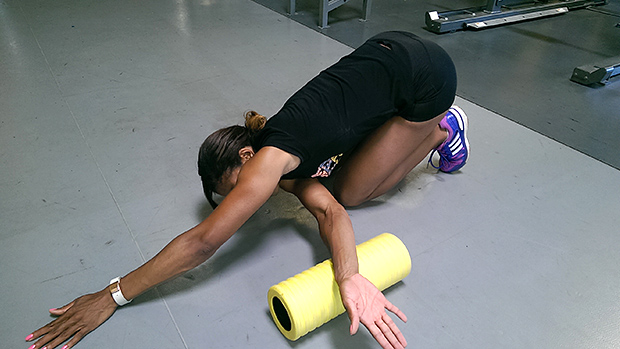An Unexpected Strength Tool
If I asked you to come up with several ways to use a brick, how many could you name? Build a house, construct a fireplace, build another house... for most people not much else comes to mind.
But what if I asked you to come up with several ways to use that same brick in a kitchen? That's when the ideas get more creative: tenderize meat, prop up a cookbook, kill a bug... you get the picture.
Changing the environment and context can spur creativity. Putting that same item in a new setting opens up a new set of possibilities.
Let's try this concept with a foam roller and strength building.


This is like the overhead squat of the pull-up. Fan of kipping? You will be exposed. Lack torso and abdominal strength? You will be exposed.
Prepare to be humbled as these can cut your numbers by 20-30%. If 15 pull-ups is your standard, don't be surprised if you only get 10-12 with this method.
Putting the knees at 90 degrees gives a co-activation of the lats, since part of the muscle originates at the hip. Add the foam roller for adduction and you get a double whammy of abdominal wall and adductor contraction that forces you to stay locked in and stiff.
It's also a quick and convenient way to advance pull-ups without going on a search for a dip belt or weight vest to add load.


Using the foam roller puts you in a fail-proof position that forces glute recruitment to bridge as opposed to digging into the hamstring for assistance. It's a solid movement for hip activation.
Place the roll under one leg. The closer you place it to your knee, the easier it becomes. Placing it closer to the foot lengthens the leaver.
Before bridging, drive the leg straight as an arrow, squeezing your quad while dorsiflexing the ankle (raising toes toward knee). It's only a 3-4 inch bridge, but it's damn effective. Just 1-2 sets of 10 to start a lower body session will do your hips good.


Bench height too high or low? Discomfort of the rear foot? This solves both problems.
I've trained Olympic Figure Skater Oli Bestandig (5'1") and former pro basketball center Greg Ostertag (7'2"). These two can't use the same bench for their rear foot, so this trick is essential for them and handy for everyone else.
Use a hollow, PVC style foam roll. Slide it over a barbell and set the bar up in a power rack around mid-calf height.
This movement is often done with the rear foot elevated too high, which puts a greater stretch on the rear quad and limits depth or makes the hip externally rotate and compensate, making it need more mobility.
The other benefit of this set-up is comfort. The little bit of cushion on the roll allows for more comfort since the foot doesn't have to go into deep plantar flexion like it does when on a bench.
Sure, you could force yourself to suck it up when it's uncomfortable, but if you're rocking RFE split squats with heavy loads, don't worry about adjusting the set-up for more comfort.
Use this as a progression from an ab wheel. The video doesn't do the challenge justice. You've got to try it to understand it.
Keep these in a low to moderate rep range, multiple sets of 5-8 reps. Going high rep on them can make the low back kick in. But you've been warned: This will leave even veteran lifters shaking like a leaf on a tree.


It's a modification similar to doing med ball push-ups, but with less stress on the wrists and elbows.
Use two rolls. They should run lengthwise with your body, allowing you to wrap your hand around it so you basically have a neutral grip. The foam rolls give a hint of instability, which increases shoulder stabilizer and torso activation.
This variation allows for a greater stretch at the bottom range. Do 2-3 sets at the start of training sessions to get blood into your pecs and shoulders.
Or use them at the tail end of a session for 2 sets of max reps, going to complete failure. Once to failure, do partials from the bottom position and finally try to squeeze an isometric hold for 5 seconds with your nose hovering right above the floor.
You'll completely exhaust the pecs and shoulders and finish off an upper body session.


Beginners: You don't get better at push-ups by doing half push-ups! You may require a simple technique fix. But if it's just a lack of strength, an easy adjustment is to put a foam roll under the knees and start with full-range push-ups here.
It's less time consuming than setting up a barbell in a power rack or searching for an empty bench to elevate the hands. If you can bust out 6-8 with the roll at the knees, the next step is to move it down to the shins. After conquering the shins, it's time to lose the training wheels!


This isn't a strength movement, but it's too good to leave out. It increases shoulder and thoracic mobility – things you need in order to train hard.
First, sit hips back to heels. When the hips pass 90 degrees in this child's pose position, it effectively puts the lumbar spine in an immovable position.
Then reach one arm out and push that hand into the ground. Same concept as the lumbar spine – you anchor one shoulder down which will allow for more pure thoracic rotation.
Place the other arm on the foam roll. Rotate and roll across the body, trying to get every inch out of the stretch.
Do a set of 10 on each side before an upper body lift.
Photo credit: Abigail Irozuru, long jumper for Great Britain looking to make it to the Olympics in 2016.




